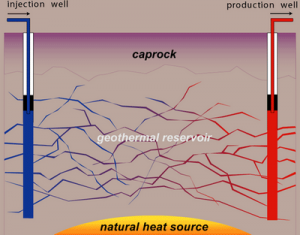EnergyCost-effective, non-polluting enhanced geothermal systems
Tapping the natural heat of the earth may be more cost-effective and clean thanks to a research into a new area of geothermal energy, called enhanced geothermal systems. These systems are designed to enable power production in areas where conventional geothermal techniques do not work. Unlike typical geothermal systems, which rely on porous rock, enhanced geothermal systems have much greater potential to tap the energy of geothermal hot spots in areas of otherwise impermeable bedrock. The potential could be especially high in the western United States, including New Mexico.

Geothermal makes use of the earth's naturally occuring heat // Source: utah.edu
Tapping the natural heat of the earth may be more cost-effective and clean thanks to a research project by New Mexico State University Assistant Professor Kenneth C. Carroll and others.
Carroll is a member of a group that has published two papers related to a new area of geothermal energy, called enhanced geothermal systems. These systems are designed to enable power production in areas where conventional geothermal techniques do not work.
NMSU reports that the group has developed a new fracturing fluid that uses an environmentally friendly polymer to create tiny cracks in bedrock deep below the surface of the earth. The cracks provide places for water to be pumped into the rock, a process called “reservoir stimulation.” There, the heat of the earth — around 150-400 degrees Celsius at depths of 900-4,000 meters — is hot enough to turn the water to steam. The steam then can be returned to the surface and used as an energy source for power plants.
Unlike typical geothermal systems, which rely on porous rock, enhanced geothermal systems have much greater potential to tap the energy of geothermal hot spots in areas of otherwise impermeable bedrock.
The potential could be especially high in the western United States, including New Mexico.
“The U.S. Geological Survey says most of the western U.S. has heat areas close to the surface,” Carroll said. “New Mexico and most of the West has basin and range geology,” characterized by narrow mountain ranges and flat basins or valleys. This often means heat sources in the earth are closer to the surface than in other areas, making geothermal development more practical.
The new fluid addresses some of the concerns about commonly used fracturing techniques used in the development of oil and gas. Those economically costly techniques require fluids and methods that generate unacceptable environmental impacts.
Carroll is part of a collaborative research project between the Pacific Northwest National Laboratory and NMSU.
“Our new fluid can make enhanced geothermal power production more viable,” Carroll said. “And, though we designed the fluid for geothermal energy, it could also make unconventional oil and gas recovery more environmentally friendly.”
The group’s findings have been published by the Royal Society of Chemistry in the journal Green Chemistry, as well as by Elsevier in Geothermics, the International Journal of Geothermal Research and its Applications.
